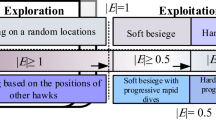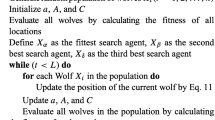Abstract
Feature selection is a preprocessing step that aims to eliminate the features that may negatively influence the performance of the machine learning techniques. The negative influence is due to the possibility of having many irrelevant and/or redundant features. In this chapter, a binary variant of recent Harris hawks optimizer (HHO) is proposed to boost the efficacy of wrapper-based feature selection techniques. HHO is a new fast and efficient swarm-based optimizer with various simple but effective exploratory and exploitative mechanisms (Levy flight, greedy selection, etc.) and a dynamic structure for solving continuous problems. However, it was originally designed for continuous search spaces. To deal with binary feature spaces, we propose a new binary HHO in this chapter. The binary HHO is validated based on special types of feature selection datasets. These hard datasets are high dimensional, which means that there is a huge number of features. Simultaneously, we should deal with a low number of samples. Various experiments and comparisons reveal the improved stability of HHO in dealing with this type of datasets.
Access this chapter
Tax calculation will be finalised at checkout
Purchases are for personal use only
Similar content being viewed by others
Notes
- 1.
Note that the codes of HHO method can be publicly downloaded from: http://www.alimirjalili.com/HHO.html and http://www.evo-ml.com/2019/03/02/hho.
- 2.
Please visit these home pages that are publicly devoted to HHO algorithm: http://www.alimirjalili.com/HHO.html and http://www.evo-ml.com/2019/03/02/hho.
- 3.
- 4.
Please refer to https://www.nature.com/articles/d41586-019-00874-8.
References
Pudil P, Novovičová J, Kittler J (1994) Floating search methods in feature selection. Pattern Recognit Lett 15:1119–1125
Seijo-Pardo B, Bolón-Canedo V, Alonso-Betanzos A (2019) On developing an automatic threshold applied to feature selection ensembles. Inf Fusion 45:227–245
Bolón-Canedo V, Alonso-Betanzos A (2019) Ensembles for feature selection: a review and future trends. Inf Fusion 52:1–12
Jin X, Xu A, Bie R, Guo P (2006) Machine learning techniques and chi-square feature selection for cancer classification using sage gene expression profiles. In: International workshop on data mining for biomedical applications. Springer, pp 106–115
Mafarja M, Aljarah I, Heidari AA, Hammouri AI, Faris H, Ala’M A-Z, Mirjalili S (2018) Evolutionary population dynamics and grasshopper optimization approaches for feature selection problems. Knowl-Based Syst 145:25–45
Heidari AA, Aljarah I, Faris H, Chen H, Luo J, Mirjalili S (2019) An enhanced associative learning-based exploratory whale optimizer for global optimization. Neural Comput Appl
Xu Y, Chen H, Heidari AA, Luo J, Zhang Q, Zhao X, Li C (2019) An efficient chaotic mutative moth-flame-inspired optimizer for global optimization tasks. Expert Syst Appl 129:135–155
Heidari AA, Mirjalili S, Faris H, Aljarah I, Mafarja M, Chen H (2019) Harris hawks optimization: algorithm and applications. Futur Gener Comput Syst 97:849–872
Kohavi R, John GH (1997) Wrappers for feature subset selection. Artif Intell 97:273–324
Crawford B, Soto R, Astorga G, Conejeros JG, Castro C, Paredes F (2017) Putting continuous metaheuristics to work in binary search spaces. Complexity 2017:1–19
Afshinmanesh F, Marandi A, Rahimi-Kian A (2005) A novel binary particle swarm optimization method using artificial immune system. In: EUROCON 2005-The international conference on Computer as a Tool, vol 1. IEEE, pp 217–220
Kennedy J, Eberhart RC (1997) A discrete binary version of the particle swarm algorithm. In: 1997 IEEE international conference on systems, man, and cybernetics, computational cybernetics and simulation, vol 5. IEEE, pp 4104–4108
Rashedi E, Nezamabadi-Pour H, Saryazdi S (2010) Bgsa: binary gravitational search algorithm. Nat Comput 9:727–745
Altman NS (1992) An introduction to kernel and nearest-neighbor nonparametric regression. Am Stat 46:175–185
Liao T, Kuo R (2018) Five discrete symbiotic organisms search algorithms for simultaneous optimization of feature subset and neighborhood size of knn classification models. Appl Soft Comput 64:581–595
Mafarja M, Aljarah I, Heidari AA, Faris H, Fournier-Viger P, Li X, Mirjalili S (2018) Binary dragonfly optimization for feature selection using time-varying transfer functions. Knowl-Based Syst 161:185–204
Faris H, Mafarja MM, Heidari AA, Aljarah I, Ala’M A-Z, Mirjalili S, Fujita H (2018) An efficient binary salp swarm algorithm with crossover scheme for feature selection problems. Knowl-Based Syst 154:43–67
Statnikov A, Aliferis CF, Tsamardinos I, Hardin D, Levy S (2004) A comprehensive evaluation of multicategory classification methods for microarray gene expression cancer diagnosis. Bioinformatics 21:631–643
Luo J, Chen H, Heidari AA, Xu Y, Zhang Q, Li C (2019) Multi-strategy boosted mutative whale-inspired optimization approaches. Appl Math Model
Benjamin DJ, Berger JO (2019) Three recommendations for improving the use of p-values. Am Stat 73:186–191
Goldberg DE, Holland JH (1988) Genetic algorithms and machine learning. Mach Learn 3:95–99
Emary E, Zawbaa HM, Hassanien AE (2016) Binary ant lion approaches for feature selection. Neurocomputing 213:54–65
Nakamura RY, Pereira LA, Costa KA, Rodrigues D, Papa JP, Yang X-S (2012) Bba: a binary bat algorithm for feature selection. In: 2012 25th SIBGRAPI conference on graphics, patterns and images. IEEE, pp 291–297
Sayed GI, Khoriba G, Haggag MH (2018) A novel chaotic salp swarm algorithm for global optimization and feature selection. Appl Intell 48:3462–3481
Author information
Authors and Affiliations
Corresponding author
Editor information
Editors and Affiliations
Rights and permissions
Copyright information
© 2020 Springer Nature Singapore Pte Ltd.
About this chapter
Cite this chapter
Thaher, T., Heidari, A.A., Mafarja, M., Dong, J.S., Mirjalili, S. (2020). Binary Harris Hawks Optimizer for High-Dimensional, Low Sample Size Feature Selection. In: Mirjalili, S., Faris, H., Aljarah, I. (eds) Evolutionary Machine Learning Techniques. Algorithms for Intelligent Systems. Springer, Singapore. https://doi.org/10.1007/978-981-32-9990-0_12
Download citation
DOI: https://doi.org/10.1007/978-981-32-9990-0_12
Published:
Publisher Name: Springer, Singapore
Print ISBN: 978-981-32-9989-4
Online ISBN: 978-981-32-9990-0
eBook Packages: Intelligent Technologies and RoboticsIntelligent Technologies and Robotics (R0)




